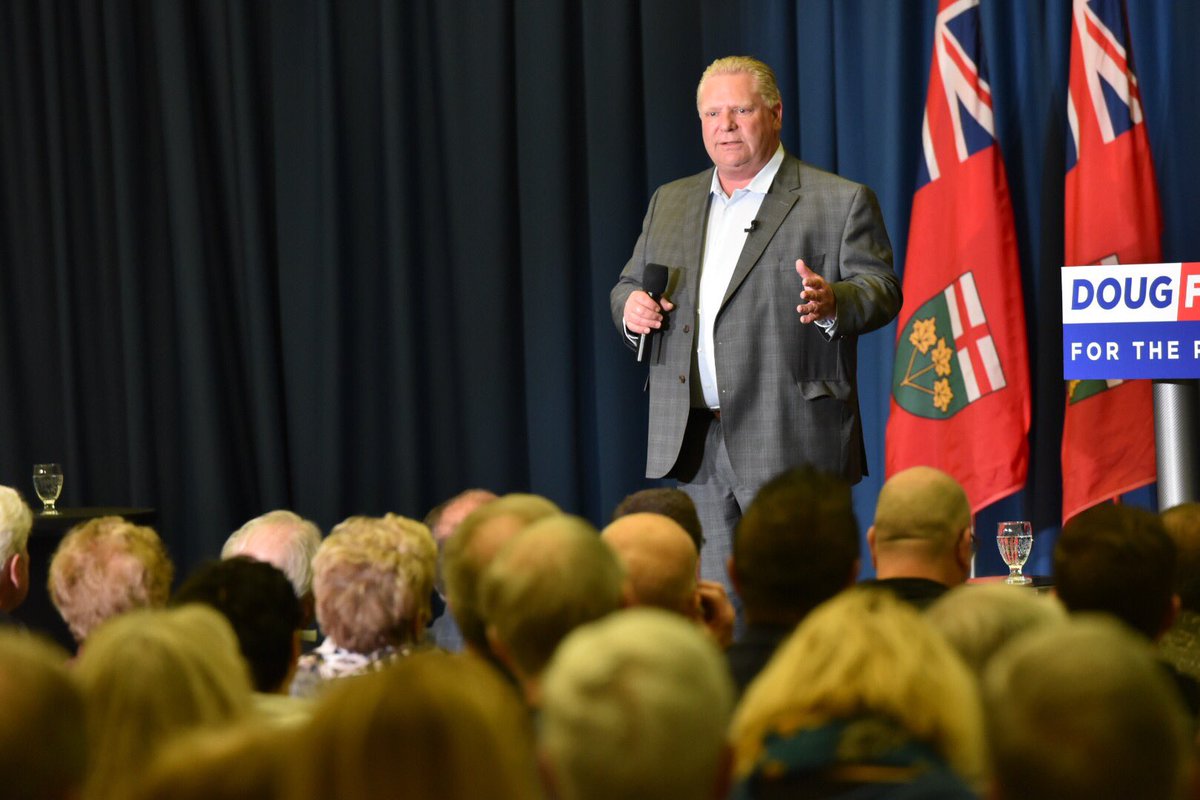Doug Ford learned a key lesson observing the crushing electoral defeat of his predecessor: never reveal where the bodies are to be buried.
Former Conservative leader Tim Hudak went into the last Ontario election humming the familiar right-wing refrain about government waste and inefficiency. But he made things specific: he said he’d eliminate 100,000 public sector jobs, thereby cutting government spending by $2 billion, allowing him to lower corporate taxes.
The private sector, brimming with confidence, would then create one million jobs, Hudak claimed. Wherever he spoke, he stood in front of a billboard proclaiming his “Million Jobs Plan.”
But as the economist Jim Stanford soon pointed out, Hudak had made some math errors, including multiplying by eight when he shouldn’t have multiplied at all.
The one million new private sector jobs quickly evaporated, leaving only the very real 100,000 public sector jobs Hudak pledged to eliminate. Suddenly it seemed like the Conservative leader was standing awkwardly in front of billboards proclaiming “100,000 Fired Public Sector Workers.”
Determined to avoid identifying victims of his cuts, Doug Ford is sticking to folksy claims about being “for the little guy” and against “the elites” (that is, anyone using words longer than one syllable).
No messy math. No identifiable bodies. With only a smile, Ford insists he’ll cut $6 billion in spending without cutting a single public sector job. He’ll simply eliminate government “inefficiencies.”
But, once we put aside right-wing mantra, it becomes clear that the biggest part of government spending goes to providing valued services, particularly health care and education, and it’s more efficient to provide these services collectively through government than to leave people on their own to buy them in the marketplace.
That’s why Americans, who are largely obliged to buy their health care privately, end up paying an astounding 16 per cent of their GDP on health care even though millions of Americans remain uninsured, while Canadians pay 10 per cent of our GDP on health care and everyone gets covered.
Ford may be coy about his cutting plans, but it’s not hard to imagine where he’d swing his axe.
We could start by looking at the tool kit of former Conservative Premier Mike Harris, whose cuts led to hospital closings, dramatic hikes in university tuition and the end of Ontario’s affordable housing programs, opening the floodgates to homelessness.
Indeed, the most vulnerable citizens always have targets on their back when governments look to save money.
It’s worth recalling that Harris took a meat cleaver to welfare benefits — cutting them by 21.6 per cent in 1995.
The Liberals, who’ve held power for 15 years, initially restored a small amount of what Harris took away, but have allowed inflation to eat that. (They’ve promised to do more, if re-elected.)
But today, a single Torontonian on welfare receives $721 a month — enough to live a marginal, near-homeless existence. Indeed, as social policy analyst John Stapleton notes, today’s welfare rate, in real dollars, is actually lower than the incredibly low rate put in place by Mike Harris.
This should serve as a cautionary tale since it suggests that, once cut, welfare benefits are difficult to restore.
After all, welfare recipients have no political clout, leaving them easy prey for politicians looking for bodies to be presented as undeserving beneficiaries of a “gravy train.”
Harris also cracked down on welfare abuse — no doubt in the interests of greater efficiency.
Those measures certainly contributed to the 2001 death of Kimberly Rogers, as an inquest revealed.
The 40-year-old was eight months pregnant and confined to her Sudbury apartment under house arrest for collecting welfare while receiving student loans. She’d taken the loans to pay for a college course, where she’d graduated near the top of her class, with dreams of becoming a social worker. After paying rent and welfare penalties, she was left with just $18 a month to live on.
“I ran out of food this weekend,” she wrote in a court appeal shortly before her suicide, “I am unable to sleep.”
Kimberly Rogers was unusual in that her miserable plight led her to take her own life.
Mostly, marginalized people suffer quietly, out of the limelight.
Doug Ford is hoping you’re not thinking about them.
Linda McQuaig is a journalist and author. Her book Shooting the Hippo: Death by Deficit and Other Canadian Mythswas among the books selected by the Literary Review of Canada as the “25 most influential Canadian books of the past 25 years.” A version of this column originally appeared in the Toronto Star.
Photo: Doug Ford/Flickr
Like this article? rabble is reader-supported journalism. 



